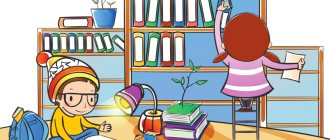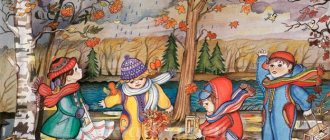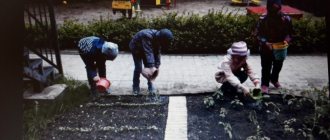Walk for children of the middle group “Autumn time”
Authors:
Milnichenko Tatyana Vasilievna,
Muslimova Liliya Rubilevna
educators
MADOU d/s No. 133, Tyumen
Target:
Summarize the signs of Autumn with your children. To foster cognitive interest in nature, to develop speech development in children. The desire to be in the fresh air, to learn to notice the beauty of nature. Loving her, trying to protect her from trash, learning to take care of her.
Objectives: - Help consolidate knowledge about trees, learn to identify trees by their characteristics, learn to distinguish the leaves of different trees; - Develop children's speech. — Enrich your vocabulary. - Train memory and attention. — Form a holistic picture of the natural world. — Foster concern for the environment.
Preliminary work:
Observing autumn nature, looking at trees, learning poems about autumn, reading works of art. Examination of a reproduction of Levitan’s painting “Golden Autumn”, as well as sketches and illustrations depicting various trees in autumn, collecting leaves on a walk.
Progress of the walk
If the leaves on the trees have turned yellow, If the birds have flown to a distant land, If the sky is gloomy, if the rain is pouring, This time of year is called autumn. Author: M. Khodyakova.
Observation:
Remind children that autumn has come. The whole ground was covered with leaves - everything around was yellow. That's why autumn is called yellow and golden. Draw the children's attention to how one leaf flies to the ground, the other spins, spins and slowly falls to the ground. Clarify that the leaves are light, so they fly to the ground slowly. The wind blew, and many leaves rustled to the ground - this is leaf fall.
Look at the leaves of different trees. Please note that the surface of the leaf blade varies from tree to tree.
Outdoor game "Falling Leaves"
The goal is to consolidate children’s knowledge about the color and size of autumn leaves. Reinforce the concept of “leaf fall.” Progress of the game. Children choose a leaf for themselves and name which leaf they chose based on size and color. Children run and wave their arms:
Leaf fall! Leaf fall! Yellow leaves are flying. (children with yellow leaves)
Leaf fall! Leaf fall! Red leaves are flying! (children with red leaves)
Beautiful yellow leaves are spinning! (children with yellow leaves)
Beautiful red leaves are spinning! (children with red leaves)
They sat down, sat down and froze.
A light breeze came and blew.
Leaves rose and scattered in different directions.
Spinning, spinning.
Leaf fall, leaf fall! Leaves are flying in the wind!
Outdoor game “ Run to the named tree.”
Goal: to train in quickly finding the named tree.
Progress of the game: The driver is selected. He names a tree, all children must listen carefully to which tree is named and, in accordance with this, run from one tree to another. The driver carefully monitors the children; whoever runs to the wrong tree leaves the game.
Sedentary game "Leaves"
Leaves are falling, falling - (Children are spinning, raising their arms up, squatting)
It's leaf fall in our garden. Yellow, red leaves (Spin again)
They curl and fly in the wind. Birds are flying south - (Running in a circle, waving their arms)
Geese, rooks, cranes. Now the last flock is flapping its wings in the distance.
Guys, let's collect colorful leaves to make a beautiful panel out of them to decorate the group. (Children and their teachers collect leaves, discussing their color, shape and from which tree they fell).
Educator: Guys, what beautiful leaves you have. You liked the walk, you would like to come here again (children's answers). Unfortunately, it's time for us to go, well done to you all!
List of used literature:
1. Teplyuk S.N. Walking exercises in the middle group. For working with children 3-4 years old. M.: -Mosaika-Sintez, 2010
2. Ulanova L.A., Jordan S.O. Methodological recommendations for organizing and conducting walks for children 3-7 years old. – SPb.: “CHILDHOOD-PRESS”, 2008
3. Author: M. Khodyakova poem “Autumn Leaves”
We invite teachers of preschool education in the Tyumen region, Yamal-Nenets Autonomous Okrug and Khanty-Mansi Autonomous Okrug-Yugra to publish their teaching materials: - Pedagogical experience, original programs, teaching aids, presentations for classes, electronic games; — Personally developed notes and scenarios of educational activities, projects, master classes (including videos), forms of work with families and teachers.
Why is it profitable to publish with us?
1. “Kindergartens of the Tyumen Region” is an officially registered specialized media outlet at the federal level. 2. The activities of the editorial office are supported by the Department of Education and Science of the Tyumen Region 3. We issue a “Certificate of Publication” in the media. 4. The document has a unique number, is entered in the register, has the original seal of the editorial office of the online publication and signature. 5. “Certificate of publication” in the media is sent to the author in both paper and electronic versions.
Details >>>
Sample “Certificate of publication of author’s methodological material in the media.”pdf
Share
Card index of walks in the middle group for the month of March
March Walk 1 Bird watching in the kindergarten area Objectives: - teach to recognize and distinguish birds by plumage, size, voice; - develop observation and memory; - cultivate a friendly attitude towards birds Literary word: In a gray fur coat, And in the cold he is a hero, Jumps, frolics in flight, Not an eagle, but still a bird. (Sparrow.) Color - grayish, Habit - furtive, Screamer hoarse - Famous person. (Crow.) She doesn’t sit still - She carries news on her tail. (Magpie.) March Walk 2 Observation of icicles Goals: - develop horizons, familiarize with natural phenomena - cultivate interest in spring observations Literary word: All the snowstorms have died down, and the frosts are no longer crackling, Drops are dripping from the roofs, and the icicles are standing in a row. Signs: If long icicles form on the roofs, spring will be protracted March Walk 3 Observation of pigeons Objectives: -to expand knowledge about the appearance of birds, their habits and habitat; -form real ideas about the life of birds. Literary word: We have known since ancient times that this bird is a postman. March Walk 4 Observation of poplar buds Objectives: -continue to get acquainted with the trees on the site; -form the idea that a bud is a house for a leaf. Literary word: There are flat lumps on the branches. Flat leaves lie dormant in them. The teacher asks the children a riddle. These small barrels will be unsealed by spring, while the leaves sleep in them and grow while they sleep. (Kidneys.) March Walk 5 Observation of the sky and clouds Objectives: - consolidate ideas about spring; - pay attention to the changes that have occurred in the sky; - develop the ability to see the beauty of the sky, creative imagination. Literary word: As a white swan swam across the sky from the north, A well-fed swan swam. Threw down in the fields of the lake, White fluff and feathers March Walk 6 Observation of the melting of snow Objectives: - teach to establish relationships in nature - continue to expand knowledge about the properties of snow, - lead to an understanding of the connection between the properties of snow and the state of the weather Literary word: Snow is now not the same one - It darkened in the field, The ice cracked on the lakes, As if it had been split. The clouds are moving faster, The sky has become higher The sparrow is chirping Having fun on the roof March Walk 7 Observing the spring sun Goals: - continue to teach children to notice and name the state of the weather; — clarify knowledge that in spring the sun shines brightly and begins to get hot; — learn to establish a cause-and-effect relationship: the sun is shining, it’s getting warmer. Literary word: Riddle: The snowball is melting and the meadow is coming to life, The day is coming - When does this happen? (In spring) March Walk 8 Observation of Drops Goals: - expand children's ideas about spring, enrich their knowledge with new words and concepts. Artistic word: Under the very cornice Above the very window The spring sun climbed into the icicles. Sparkling, tears run along the icicles... And the icicles melt - cheerful pieces of ice (I. Demyanov) March Walk 9 Observing spring changes in nature Objectives: - to teach to observe changes in the world around us with the arrival of spring; - develop the ability to see changes in the behavior of birds and plants; - cultivate interest in observing birds, plants and people. Artistic word: Riddle: It rings outside the window And sings “Spring has come! And the cold icicles turned into these streams!” Sunshine from the roof “Splash – Splash – Splash!” This is a small flood (Kapel) March Walk 10 Observation of the work of a janitor Objectives: - to develop a willingness to help, the ability to evaluate the results of work; — cultivate respect for working people; — develop speech, increase vocabulary (name and purpose of the janitor’s work equipment). Artistic word: Sunny bunnies playing on the ground. I will beckon them with my finger - Let them run to me. - Well, spring, how are you? - I have cleaning to do. - What do you need a broom for? — Sweep the snow from the hillock. -What do you need streams for? — Wash away the trash from the paths. -What do you need the rays for? - For cleaning too.
We recommend watching:
Spring fun for middle school children. Scenario: Meeting of Spring Integrated lesson for children of the middle group: Spring is red Synopsis of an integrated lesson in the middle group on the topic: Spring in the forest Synopsis of immediate educational activities in the middle group on the topic: Spring
Similar articles:
Walk observation in the older group. Early spring
Observing the sky and clouds in the senior group in spring
Walk “Migratory Birds”. Senior group. Spring
Observation “Trees and shrubs in spring.” Senior group
Walk “Observing a Dandelion” in the senior group


